Diversity = Great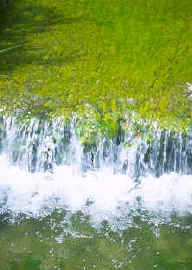
Genera = 450 & Species = 7,000
Color
The colors of Chlorophyta range from Green to Orange. The orange
color is due to Carotenoids which form the Accessory Pigments for this Division.
Their Photosynthetic Pigments
are Similar to those of Vascular Plants.
Chlorophyll a, b are
typically present 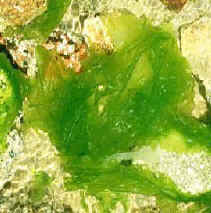 along with
along with
a, b Carotene
plus Xanthophylls.
The Cell Wall
is very similar to that of terrestrial plants because its main components are Cellulose & Pectins.
Some species deposit Calcium Carbonate in their walls.
Halimeda is a good example of this.
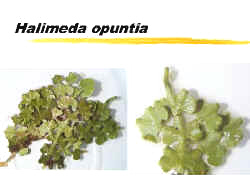
Occurrence
This Division has a larger
number of Freshwater species than Marine
species. Marine species tend to be larger than those found in freshwater. However, the
Chlorophyta do not produce organisms that approach the size of large Kelps
A few species exist on snow
fields and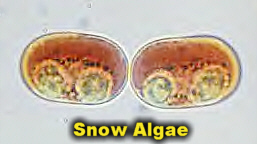 Glaciers. They tend
to have high concentrations of Carotenoids which are responsible for the red hue of their
cells. These are called "Snow Algae". They can be found in the Rocky Mountains, the Cascades, the Arctic and
Antarctic, as well as most areas where there are permanent or semi-permanent snow-fields.
It would be interesting to see if they occurred on the volcanic peaks of Hawai'i.
Glaciers. They tend
to have high concentrations of Carotenoids which are responsible for the red hue of their
cells. These are called "Snow Algae". They can be found in the Rocky Mountains, the Cascades, the Arctic and
Antarctic, as well as most areas where there are permanent or semi-permanent snow-fields.
It would be interesting to see if they occurred on the volcanic peaks of Hawai'i.
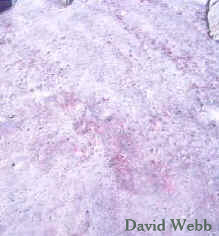
Untroden Red Snow |
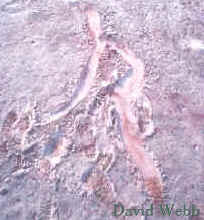
Red Snow containing footprints of a Yeti named David Webb |
A
few species are Terrestrial.
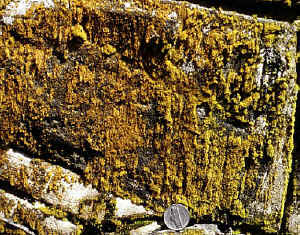
Trentepohlia eljunque is Terrestrial

Life
Modes - They are predominately autotrophs.
Some
species form Symbioses with Lichens, Hydras & Mollusks.
Ultrastructure
They are Eukaryotes and have the
"Usual Suspects" when it comes to organelles.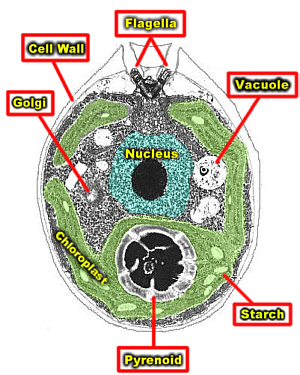
Some species form Cell Plates that are similar to those found
in land plants.
Some species have Flagella. However, flagellated cells are usually Gametes or Spores
Chloroplasts have the typical Double Boundary Membrane.
The Thylakoids can produce Parallel
Bands of Three, Irregular Stacks as well as Grana.
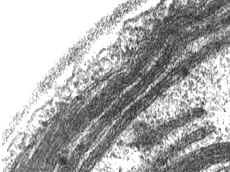 |
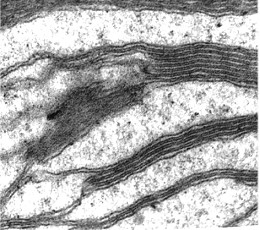 |
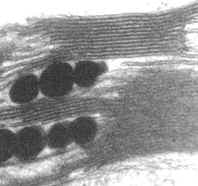 |
| Chloroplasts Irregular Bands Stacking Thylakoids |
Chloroplast Bands of 3 Thylakoids |
Chloroplasts with Grana |
Chloroplast
Shape varies. The trend is towards an increase in Surface Area.
Common
Chloroplasts Shapes include
|
Cup
Filament Star Reticulate (Net)
Banded
|
Few
have the Discoid Shape of most Terrestrial Plants |
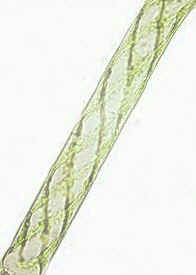
Spirogyra has spiral Chloroplasts |
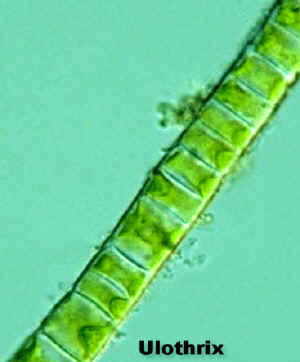
Ulothrix has band-shaped Chloroplasts |
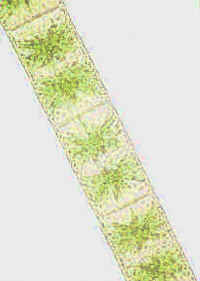
Zygnema has Star-shaped Chloroplasts |
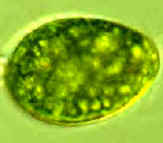
Chalmydomonas has one cup-shaped Chloroplast |
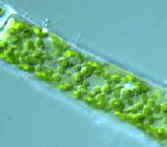
Cladophora has many small oval Chloroplasts |
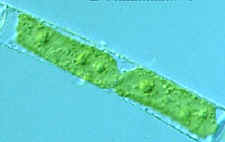
Mougeotia has a flat Chloroplast. The disk-like areas are Pyrenoids. |
Pyrenoids occur
in most species.
Starch is the
major storage product. Starch is stored in the
Stroma of the Chloroplast.
This is unusual for Algae. It tends to make the
Chloroplasts have a lumpy appearance. Note the Chalmydomonas above.
Most Algae store starch in the
Cytoplasm.
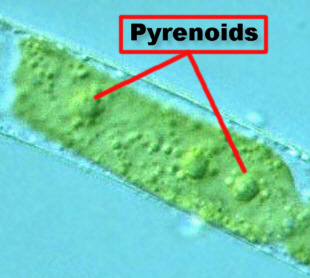
|
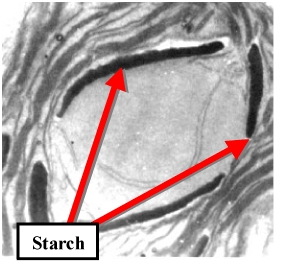 |
| Light Microscope Photo of Pyrenoids in
Mougeotia Chloroplast |
EM Photo of a Pyrenoid in Chlamydomonas |
Morphological Diversity
There is a wide range of morphological diversity . There are
Unicellular, Filamentous, Siphonous, Multicellular, Colonial, Parenchymatous, Motile,
Nonmotile types.
Their Size Ranges from microns to 8m.
The Chlorophyta have been divided into
several Classes by Taxonomists. There is no, one absolute classification system at this
time. I will present a more traditional scheme to organize these lectures. I am not going
to stress Taxonomy for these lectures. However, I will mention some of the major groups as
we study their morphological and reproductive adaptations. I want you to see the major
morphological and reproductive trends for this division as well as the progression of
traits which could have led to the first truly land plants. Dr. Smith offers several
courses which look critically at algal Taxonomy, Ecology & Physiology.


 along with
along with
 Glaciers. They tend
to have high concentrations of Carotenoids which are responsible for the red hue of their
cells. These are called "Snow Algae". They can be found in the Rocky Mountains, the Cascades, the Arctic and
Antarctic, as well as most areas where there are permanent or semi-permanent snow-fields.
It would be interesting to see if they occurred on the volcanic peaks of Hawai'i.
Glaciers. They tend
to have high concentrations of Carotenoids which are responsible for the red hue of their
cells. These are called "Snow Algae". They can be found in the Rocky Mountains, the Cascades, the Arctic and
Antarctic, as well as most areas where there are permanent or semi-permanent snow-fields.
It would be interesting to see if they occurred on the volcanic peaks of Hawai'i.








